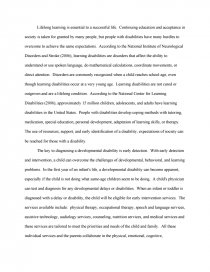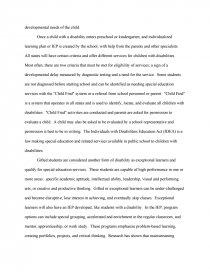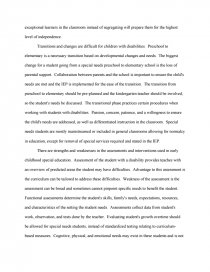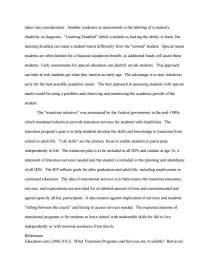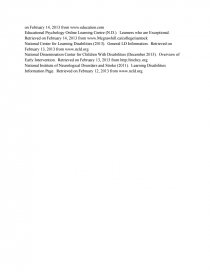Lifelong Learning
Essay by romocast • March 5, 2013 • Research Paper • 1,381 Words (6 Pages) • 2,193 Views
Lifelong learning is essential to a successful life. Continuing education and acceptance in society is taken for granted by many people, but people with disabilities have many hurdles to overcome to achieve the same expectations. According to the National Institute of Neurological Disorders and Stroke (2006), learning disabilities are disorders that affect the ability to understand or use spoken language, do mathematical calculations, coordinate movements, or direct attention. Disorders are commonly recognized when a child reaches school age, even though learning disabilities occur at a very young age. Learning disabilities are not cured or outgrown and are a lifelong condition. According to the National Center for Learning Disabilities (2006), approximately 15 million children, adolescents, and adults have learning disabilities in the United States. People with disabilities develop coping methods with tutoring, medication, special education, personal development, adaptation of learning skills, or therapy. The use of resources, support, and early identification of a disability, expectations of society can be reached for those with a disability.
The key to diagnosing a developmental disability is early detection. With early detection and intervention, a child can overcome the challenges of developmental, behavioral, and learning problems. In the first year of an infant's life, a developmental disability can become apparent, especially if the child is not doing what same-age children seem to be doing. A child's physician can test and diagnosis for any developmental delays or disabilities. When an infant or toddler is diagnosed with a delay or disability, the child will be eligible for early intervention services. The services available include: physical therapy, occupational therapy, speech and language services, assistive technology, audiology services, counseling, nutrition services, and medical services and these services are tailored to meet the priorities and needs of the child and family. All these individual services and the parents collaborate in the physical, emotional, cognitive, developmental needs of the child.
Once a child with a disability enters preschool or kindergarten, and individualized learning plan or IEP is created by the school, with help from the parents and other specialists. All states will have certain criteria and offer different services for children with disabilities. Most often, there are two criteria that must be met for eligibility of services; a sign of a developmental delay measured by diagnostic testing and a need for the service. Some students are not diagnosed before starting school and can be identified as needing special education services with the "Child Find" system or a referral from school personnel or parent. "Child Find" is a system that operates in all states and is used to identify, locate, and evaluate all children with disabilities. "Child Find" activities are conducted and parents are asked for permission to evaluate a child. A child may also be asked to be evaluated by a school representative and permission is best to be in writing. The Individuals with Disabilities Education Act (IDEA) is a law making special education and related services available in public school to children with disabilities.
Gifted students are considered another form of disability as exceptional learners and qualify for special education services. These students are capable of high performance in one or more areas: specific academic aptitude, intellectual ability, leadership, visual and performing arts, or creative and productive thinking. Gifted or exceptional learners can be under-challenged and become disruptive, lose interest in achieving, and eventually skip classes. Exceptional learners will also have an IEP developed, like students with a disability. In the IEP, program options can include special grouping, accelerated and enrichment in the regular classroom, and mentor, apprenticeship, or work study. These programs emphasize problem-based learning, creating portfolios, projects, and critical thinking. Research has shown that mainstreaming exceptional learners in the classroom instead of segregating will prepare them for the highest level of independence.
Transitions and changes are difficult for children with disabilities. Preschool to elementary is a necessary transition based on developmental changes and needs. The biggest change for a student going from a special needs preschool to elementary school is the loss of parental support. Collaboration between parents and the school is important to ensure the child's needs are met and the IEP is implemented for the ease of the transition. The transition from preschool to elementary should be pre-planned and the kindergarten teacher should be involved, so the student's needs be discussed. The transitional phase practices certain procedures when working with students with disabilities. Passion, concern, patience, and a willingness to ensure the child's needs are addressed, as well as differentiated instruction in the classroom. Special needs students are mostly mainstreamed or included in general classrooms allowing for normalcy in education, except for removal of special services required and stated in the IEP.
There are strengths and weaknesses in the assessments and interventions used in early childhood special education. Assessment of the student with a disability provides teaches with an overview of predicted areas the student may have difficulties. Advantage to this assessment is the curriculum can be tailored to address these difficulties. Weakness
...
...
